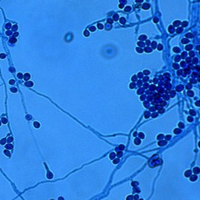Scedosporium species and Lomentospora prolificans in Italian cystic fibrosis patients: prevalence and distribution in seven centers using a selective medium

Accepted: 18 February 2021
HTML: 7
All claims expressed in this article are solely those of the authors and do not necessarily represent those of their affiliated organizations, or those of the publisher, the editors and the reviewers. Any product that may be evaluated in this article or claim that may be made by its manufacturer is not guaranteed or endorsed by the publisher.
Authors
Background and aims. Scedosporium species and Lomentospora prolificans are the filamentous fungi isolated more frequently from the cystic fibrosis (CF) lower airways, after Aspergillus fumigatus. Previous studies showed that, in CF patients, Scedosporium species and Lomentospora prolificans are responsible for airways colonization/ infection, enhancing pulmonary deterioration, and for severe invasive infections in CF patients undergoing lung transplantation. Aims of our project were to evaluate the prevalence of Scedosporium and Lomentospora species in Italian patients with CF, and to evaluate the interest of the Scedosporium-selective colture medium SceSel compared to routinely used agar-based culture media, in order to improve laboratory diagnostic performances.
Materials and methods. A total of 1977 sputum samples from 1154 CF patients were collected and processed according to CF Italian recommendations in the year 2017 (January 1st to December 31st). The SceSel agar was used in addition to the routine culture procedures to burst growth and isolation of Scedosporium/ Lomentospora species. The fungal isolates were identified by classical mycological methods and polymerase chain reaction-based DNA sequencing of ITS1 and ITS4 regions. Susceptibility of the isolates to antifungal drugs was investigated by E-test method.
Results. Among the 1154 enrolled patients, 62 (5.3%) were positive for Scedosporium/Lomentospora species (median age: 27y; range 8-64y; 33 male). Out of 1977 samples, 93 were positive for Scedosporium/Lomentospora species, and 13 (13.9%) were recovered only on SceSel agar. According to molecular analyses, isolation rates of each species were: S. apiospermum 53.1%, S. boydii 37.5%, L. prolificans 6.3% and S. aurantiacum 3.1%. Amphotericin B minimum inhibitory concentration (MIC) values were above or equal to 2 mg/L in all strains. Voriconazole MIC values were below or equal to 0.38 mg/L in almost all strains, proving this drug to be the most effective antimycotic for members of Scedosporium species. Otherwise, Lomentospora prolificans showed to be resistant to all considered antifungal drugs, only Voriconazole seems to be active on some Lomentospora prolificans isolates.
Conclusions. Our results suggest that SceSel agar should be used in combination with routine media as standard microbiological protocol and procedures are not always adequate to isolate Scedosporium and Lomentospora species in CF respiratory samples. Molecular identification and susceptibility tests are needed, especially for strains isolated from critical patients and those considered for transplantation, as they might develop invasive scedosporiosis.
How to Cite
PAGEPress has chosen to apply the Creative Commons Attribution NonCommercial 4.0 International License (CC BY-NC 4.0) to all manuscripts to be published.

 https://doi.org/10.4081/mm.2021.9335
https://doi.org/10.4081/mm.2021.9335



